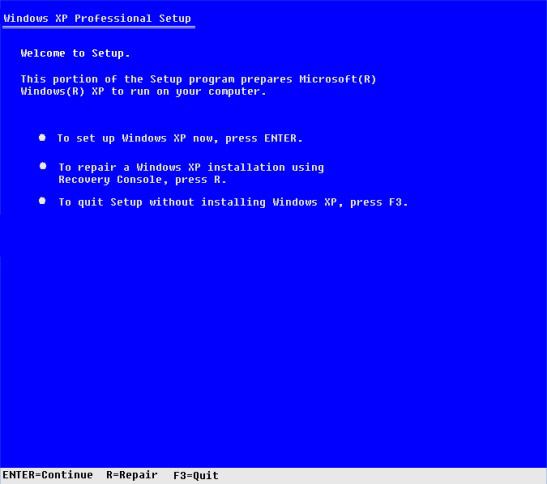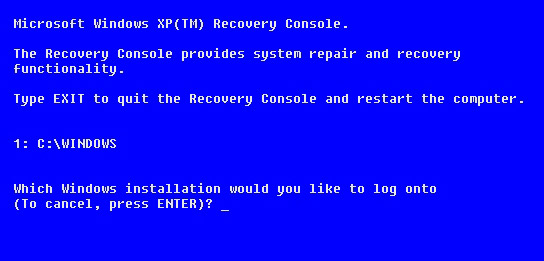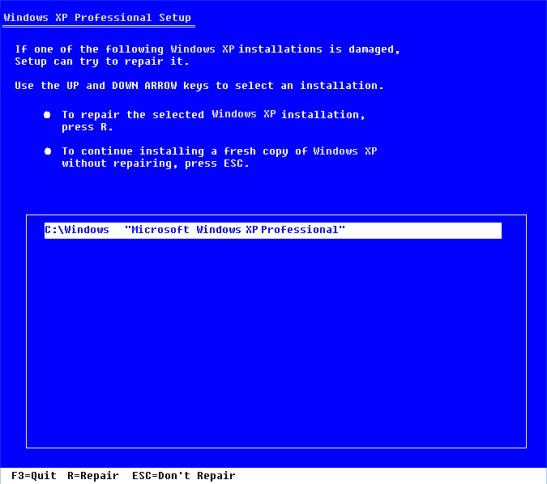10 things to do when Windows XP does not start
When your computer hardware doesn't have a problem, but Windows XP does not completely boot properly, study this article.It will show you the steps to take to solve the problem from entering the operating system, learning and 'handling' the problems that caused the machine error.
1, Use Windows boot disk
One of the first things to do to solve the problem when Windows XP fails to boot is to use the boot disk. Boot floppy is the right choice if the problem is caused by the boot record of the main partition or system files used to boot Windows error.
To create a boot disk, insert the floppy disk into the floppy drive (the same Windows XP operating system), go to My Computer , right-click the floppy disk icon, select Format from the menu that appears. When you see the Format dialog box appear, remove all default settings and then click the Start button on the dialog box. When the format finishes, close the Format dialog box and return to My Computer, double-click the drive icon C (Windows drive) to access the root folder and copy the following 3 files to the floppy:
- Boot.ini
- NTLDR
- Ntdetect.com
After you have created the boot disk, insert the disk into the floppy drive of the error system and press Ctrl + Alt + Del to restart the computer. When booting the system from the boot floppy, the computer will bypass the primary partition and boot files on the hard drive, instead it will try to boot Windows XP normally.
2, Use Last Known Good Configuration
You can try to boot the operating system using the Last Known Good Configuration feature. With this feature, you can remove any changes that may cause system errors in the CurrentControlSet registry key, which is the key that defines the hardware and driver settings. The Last Known Good Configuration feature will change the content of the CurrentControlSet key with a copy of itself created during the last system startup when no problems have occurred.
To use Last Known Good Configuration, you must first restart the computer by pressing Ctrl + Alt + Del. When receiving the Please select the operating system to start message or hear a beep, press F8 to display the Windows Advanced Options menu. Select the Last Known Good Configuration item from the menu and press Enter .
Always remember that you can only use the Last Known Good Configuration feature the first time you encounter an error. In case the error occurred after the first startup has failed, the copy file of CurrentControlSet key has also failed.
3, Use System Restore
Another tool that can help you in this case is System Restore. System Restore is a background program and constantly checks for changes in key components of the system. When it detects an imminent change, System Restore immediately creates backups (called restore points) of key components before that change takes place. In addition, System Restore is configured by default to create restore points once a day.
To use System Restore, you must first restart your computer by pressing Ctrl + Alt + Del. When you see the Please select the operating system to start message or hear a beep, press F8 to display the Windows Advanced Options menu. Select Safe Mode from the menu and press Enter .
When Windows XP has been started in Safe mode, click the Start button, go to All Programs | Accessories | System Tools and select System Restore . Because you are running the computer in the optional Safe mode in the System Restore wizard window, it opens only Restore My Computer To An Earlier Time and it is selected by default, so your next task is to click on Next button. Follow the instructions to select the restore point and start the system recovery process.
4, Using Recovery Console
When the Windows XP boot problem is not resolved, you need to use a more robust method. The Windows XP CD is a good method and it will give you a tool called Recovery Console.
To boot from the Windows XP CD, insert the disc into the CD-ROM drive of the error system and press Ctrl + Alt + Del to restart the computer. When the system starts booting from the CD, follow the steps that are asked to download the basic files needed to run Setup. When you see the Welcome To Setup screen, as shown in Figure A, press the R key to start the Recovery Console process.

Picture A
You will see a Recovery Console menu, as shown in Figure B. It displays a folder containing the operating system's system files and a prompt to select the system you want to log into. Just press the number corresponding to the list on the keyboard, you will be prompted to enter the Administrator password.

Figure B
5, Fix the error Boot.ini file
When the Windows XP operating system starts to load, the Ntldr program will move to the Boot.ini file to determine the location of the resident system files and options that can be enabled for the operating system to continue loading. Therefore, if there is an error in the Boot.ini file itself, it may not respond to Windows XP parameters to boot the system properly.
If you think that Windows XP cannot be booted because Boot.ini has failed, you can use the special Recovery Console version of the Bootcfg tool to fix it. Of course, you must first boot the system using the Windows XP CD and access the Recovery Console as instructed in section 4.
To use the Bootcfg tool from the Recovery Console command, enter the following command:
Bootcfg / [parameter]
With [parameter] is one of the following options:
- / Add - Scans all Windows installations on your hard drive and allows you to add a new entry to the Boot.ini file.
- / Scan - Scans all Windows installations on the hard drive.
- / List - List each entry in the Boot.ini file.
- / Default - Set the default operating system to boot.
- / Rebuild - Completely recreate the Boot.ini file. Users will have to confirm each step.
- / Redirect - Allows the boot system to be redirected to a specific port when using the Headless Administration feature. The Redirect parameter comes with two other parameters [Port Baudrate] | [UseBiosSettings].
- / Disableredirect - Disables redirection.
6, Modify partition boot sector error
Partition boot sector is a small section located on the hard drive partition containing the file system information of the operating system (NTFS or FAT32), although it is a very small computer language program but it is decided to download the system. operating.
If you think that Windows XP won't boot because the partition boot sector is corrupted, you can use a special Recovery Console tool called Fixboot to fix it. Boot the system with the Windows XP CD and access the Recovery Console as shown in section 4.
To use the Fixboot tool, enter the Recovery Console command you type:
Fixboot [Domain name]:
With [Domain Name] is the drive letter you want to write a new partition boot sector.
7, Fix the error master boot record
The master boot record is located in the first sector of the hard drive and it is responsible for loading the Windows boot process into the machine. The master boot record contains a partition table of the drive which is also a small program called the Master boot code, which is responsible for determining the active or bootable partition in the partition table. When this process starts, the partition boot sector will take over and start loading Windows. If the master boot record is corrupted, the partition boot sector cannot perform its job and Windows will not start.
If you think that Windows XP won't boot because the master boot record is corrupted, you can use the Recovery Console Fixmbr tool to fix it. First, boot the system using the Windows XP CD and access the Recovery Console as shown in section 4.
To use the Fixmbr tool, enter the Recovery Console command line:
Fixmbr [Name]
With [Name] is the name of the drive where you want to write a new master boot record. For example, the format name section for a C drive configuration may start as follows:
DeviceHardDisk0
8, Disable the automatic restart process
When Windows XP encounters a fatal error, the default setting for this error is to automatically restart the system. If an error occurs when Windows XP is booting, the operating system will start getting stuck in a restart loop instead of starting normally. In this case, you will need to disable the automatic restart option in the system error.
When Windows XP starts booting and you see the Please select the operating system to start message or hear a beep, press the F8 key to display the Windows Advanced Options menu. Then, select the Disable The Automatic Restart item on the System Failure and press the Enter key. Windows XP will now hang when it encounters an error and, if possible, it will display a stop message so you can know the problem is in error.
9, Restore from a backup
If you don't seem to be able to repair the Windows XP system that's corrupted and you have a recent backup, use it to restore the system from a backup device. The method used to restore the system depends on the backup utility you used, so you will have to follow the utility's instructions to restore your system.
10, Perform upgrade error correction
If you are unable to restore a corrupted Windows XP system and do not have the latest backup, you can perform a bug fix (overwrite the old Windows). Perform reinstallation of the operating system in the same directory, just like when you upgrade to another Windows version. This type of installation will almost solve all Windows problems, not just failing to boot.
Doing this type of installation is very simple. Insert the Windows XP CD into the CD-ROM drive, restart the system from the CD. When the initial preparation process is finished, you will see the Windows XP Setup screen (as shown in Figure A above). Press Enter to start the Windows XP Setup process. You will now see the License Agreement page and need to press the F8 key to agree with the license agreement. The installation process will then search the hard drive and the version of Windows XP installed on your computer. When found, it will prompt the second Windows XP Setup screen as shown in Figure C.

Figure C
This screen will give you a choice between pressing R to repair the selected installation or press Enter to install a completely new operating system. In this case, the repair operation also means upgrading the error, so press the R key. The Setup process will look at the drives in the system, then it will start the upgrade process.
Keep in mind that, after upgrading a bug fix or installing a fix, you must reinstall all updates for Windows to block errors that may be hacker attacks.
You should read it
- How to fix Windows 10 not booting error
- Fix the Unmountable Boot Volume error on Windows 10
- Steps to fix errors 0xc0000225 on Windows Vista / 7/8 / 8.1 / 10
- Instructions to fix Windows error does not boot
- 2 ways to fix the error can not boot into Windows
- Windows 10 won't boot? Here are 10 steps to fix Windows 10 not starting
 Disrupt and save time with 10 Windows XP tips
Disrupt and save time with 10 Windows XP tips Living with Vista without XP
Living with Vista without XP Build a recovery disk for XP SP3
Build a recovery disk for XP SP3 Turn the interface of Vista into XP
Turn the interface of Vista into XP Schedule Windows XP to defragment the disk
Schedule Windows XP to defragment the disk 6 steps to improve Windows XP speed
6 steps to improve Windows XP speed